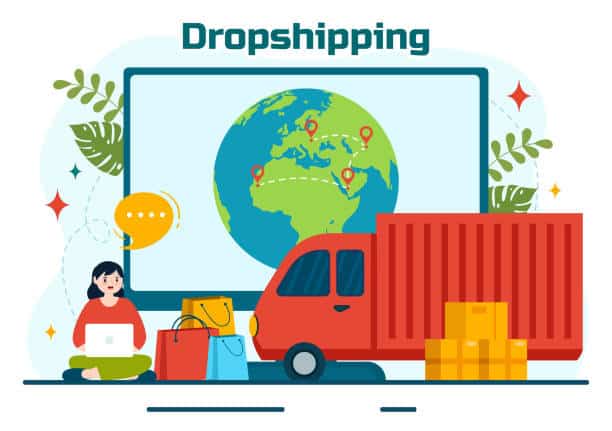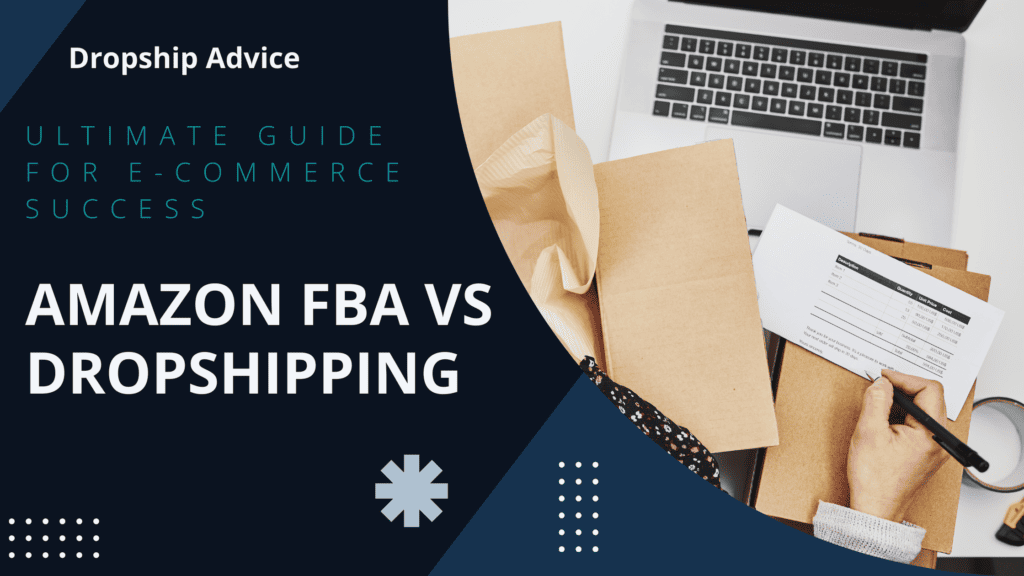To Start dropshipping business in 2024 is a great opportunity for aspiring entrepreneurs in a wide range of fields. It covers choosing the right niche and suppliers, setting up your online store, and improving marketing.
You’ll learn how to use the latest tools and trends. You’ll learn to manage inventory without upfront costs. And you’ll learn to scale your business well. This is the ultimate guide to start dropshipping business.
It does not matter if you’re a seasoned entrepreneur or a beginner. This guide gives you the info and tools to succeed. It’s for the competitive world of dropshipping. It will help you turn your e-commerce dreams into reality.
What Is Dropshipping?
Dropshipping is a retail method. A store doesn’t keep the products it sells in stock. Instead, when a store sells a product, it buys the item from a third party.
This party is usually a wholesaler or manufacturer. The store then has the item shipped directly to the customer.

As a result, the seller doesn’t need to handle the product directly. This model allows entrepreneurs to start an online business with little upfront investment.
They don’t need to buy inventory or manage warehousing. Dropshipping involves three main players: the retailer, the supplier, and the customer.
How does the dropshipping business model work?
Dropshipping is a business model that lets retailers sell products without holding inventory.
Here’s how it works:
A retailer sets up an online store and lists products sourced from third-party suppliers. A customer orders from the product pages and pays.
The retailer then buys the product from the supplier at a wholesale price and gets the customer’s shipping details.
The supplier ships the product to the customer under the retailer’s brand name.
This process ensures the retailer doesn’t need to handle inventory and avoids storing it, reducing upfront costs and logistical issues. The retailer’s profit comes from the margin.
It is the difference between the price charged to the customer and the price paid to the supplier. The first is the retail price. The second is the wholesale price.
The retailer’s main jobs are to manage the online store, select reliable suppliers, handle customer service, and drive sales with effective marketing.
Is Dropshipping Easy to Start?
Many see dropshipping as an easy business to start. It requires little upfront investment and eliminates the need for inventory management.
Entrepreneurs can set up an online store and partner with suppliers who handle stocking and shipping products to customers.
This model reduces the risks and costs associated with traditional retail businesses. Although the initial setup might be easy, success in dropshipping requires careful choice of niche products.
It also needs effective marketing, reliable suppliers, and great customer service.
The market is competitive and demands constant change to stay ahead. So, starting dropshipping is easy. But to succeed, you need to work hard and plan well.
Start Dropshipping Business:
Here are the step when you are starting a dropshipping business.
The 8-Step to Start Dropshipping Business Plan
To start a dropshipping business, follow several key steps. They will ensure you’re set up for success. Here’s an 8-step plan to guide you through the process:
Choose a Niche
Identify a niche market that interests you and has sufficient demand. Consider factors like market trends, competition, new products and potential profit margins.
It would help if you chose a niche. You must be passionate about its structure.
Conduct Market Research
Analyze your niche to understand the target audience, competition, and product descriptions. Also, look at market demand.
Use tools like Google Trends, keyword planners, and competitor analysis to gather insights. This research will help you refine your product offerings and marketing strategies.
Find Reliable Suppliers
Partner with trusted suppliers. They offer good products, low prices, and on-time shipping.
Use platforms like AliExpress, Oberlo, or SaleHoo to find suppliers. Ensure they have good reviews and can meet your quality and delivery expectations.
Set up your online store
Choose an e-commerce platform like Shopify, WooCommerce, or BigCommerce to build it.
Customize your store’s design. Create product listings with detailed descriptions and good images. Then, set up payment gateways.
Develop a Marketing Strategy
Make a full plan to attract and keep customers. Use social media marketing. Use selling channels. Use content marketing. Use affiliate marketing. Use email marketing.
Use influencer marketing. Use search engine optimization (SEO). Paid ads, such as Google Ads or Facebook Ads, can also drive traffic to your store.

Set up your business’s operations
Set up your business’s operations including customer service, orders, and returns. Make sure your website is secure. Set up tools to track performance and gather data on customer behaviour.
Launch Your Store
Launch your online store once everything is in place. Announce your launch through social media and email. Use other marketing channels, too. Aim the announcement at your target audience.
Offer promotions or discounts. They include low prices. They aim to attract initial customers. They also aim to encourage word-of-mouth referrals.
Monitor and Optimize
Continuously monitor your store’s performance using analytics tools. Track key metrics such as sales, traffic, and customer feedback.
Use this data to make informed decisions, optimize your marketing, improve your products, and enhance the customer experience.
Start a Dropshipping Business for Free:
You can start a dropshipping business for free, but it has limits and challenges.
Dropshipping’s core idea is that you don’t need to invest in inventory at first, which cuts initial costs significantly.
But, there are still essential expenses to think about. These include setting up a website or e-commerce platform.
They typically cost money unless you use entirely free platforms with limited features. Also, you can list products from reliable suppliers without paying until you make a sale.
But, marketing your store takes time and may cost money for ads.
Start using free trials or open-source platforms for your website to cut costs. Use social media and content marketing for initial promotion. Also, negotiate with suppliers for good terms.
Starting a dropshipping business with no upfront investment is tough, but it’s doable with smart planning and effective resource use.
Dropshipping businesses for sale:
There are several online platforms where you can find dropshipping businesses for sale. Websites like Shopify Exchange, Flippa, and Empire Flippers focus on buying.
They focus on selling online businesses. This includes dropshipping stores. They list established businesses.
The enterprises have detailed metrics on revenue, traffic, and profit. You can use these metrics to judge their performance before buying.
Also, eBay and Craigslist sometimes feature dropshipping businesses for sale. But, they may offer fewer protections. They also need more transparency than dedicated business brokerage platforms.
When buying a dropshipping business, you must do thorough due diligence. This includes reviewing finances, assessing suppliers, and understanding the competition in the niche.
Best products for dropshipping:
Focus on niche markets. There is specific demand and less competition. Niche products can target passionate or specialized audiences. They allow you to stand out in the market.
Light and compact products are better. They cost less to ship. This can help keep profits up.
High-Profit Margins: Look for products with good margins. This ensures that your revenue is higher than your costs. These costs include advertising and supplier fees.
Consider products in two categories. The first is evergreen, with consistent demand. The second is trending. Trending products can take advantage of short spikes in consumer interest, but evergreen products offer more stable long-term sales potential.

Solves a Problem. Products that solve a need attract more buyers. Focus on products that provide practical benefits or enhance lifestyles.
Seasonal Considerations: If they align with your niche, be mindful of seasonal products. Seasonal products can bring high sales at certain times of the year, but they may have lower demand outside of their peak season.
Quality and Reviews: Choose products with good reviews and positive customer feedback. Ensuring quality can reduce return rates and build trust with your customers.
Check that the products comply with the rules and standards in your target markets. This will avoid legal issues.
Why should you dropship from US suppliers?
Dropshipping from US suppliers has several benefits. These can help both you as a business owner and your customers:
- US suppliers ship to US customers faster than international suppliers, which can lead to happier customers. They get their orders quicker and are less likely to complain about slow shipping.
- Shipping costs can vary, especially with carrier rates changing. Within the US, shipping tends to be cheaper than international shipping. Lower shipping costs can raise profits and allow you to offer low prices to customers.
- Quality Control is Improved. US suppliers help you have better control. They make more reliable products. US-based suppliers usually follow strict standards for making and quality, which can reduce the risk of getting defective or subpar products.
- Communication and customer service are easier. US suppliers can simplify talking to them due to shared language and time zones. This can improve customer service. It will make it easier to resolve issues, answer questions, and handle inquiries fast.
- Some customers prefer to support businesses that use local suppliers. They see it as helping the local economy and ensuring ethical business. Highlighting US-based suppliers in your marketing can resonate positively with these customers.
- Importing products from overseas suppliers can be complex. It involves customs duties, import taxes, and following rules. Dropshipping from US suppliers reduces these risks and makes it easier to follow local laws and rules.
- US suppliers offer more flexibility and scalability. This is as your business grows. It can be easier to negotiate terms. You can also manage inventory levels and expand product offerings. This is true when dealing with suppliers in the same country.
Three tips for successful dropshipping:
Choose Your Niche Wisely
Picking the right niche is key to dropshipping success. Aim for a niche with sufficient demand that is not manageable by competitors.
Consider factors like profitability, market trends, and your interests or expertise. Choosing a niche allows you to focus your marketing and target your ideal customers.
Focus on Marketing and Customer Acquisition
Good marketing is vital for driving traffic to your dropshipping store. It also turns visitors into customers. Invest in digital marketing strategies.
These include social media ads, SEO, content, and email marketing. Build a strong online presence. Engage with your audience.
Prioritize Customer Service and Experience
It can also build customer loyalty. Respond quickly to questions and issues. Make sure communication is clear during the buying process.
Also, handle returns or refunds well. Pay attention to customer feedback. Use it to improve your products and services nonstop.
Focus on these three tips: Choose the right niche, invest in effective marketing, and prioritize customer service.
Doing so can enhance the likelihood of success in your dropshipping venture. Adaptability, persistence, and a love of learning are crucial.
It would help if you also optimize your strategies. These traits are key for long-term growth and profit.
Is Dropshipping Worth It?
Dropshipping can be worth it. It’s for those who want a low-risk entry into e-commerce with little upfront investment. It allows entrepreneurs to test products and niches.
They can do this without the burden of managing inventory and storage costs. They can do this with this dropshipping platform. Operating from anywhere is flexible. Scaling fast is a big advantage.
However, dropshipping success is not guaranteed. It depends on several factors, including choosing the right products, effective marketing, and strong supplier relationships.

The market is competitive, and profit margins may be thin. Suppliers control product quality and delivery, which can pose challenges.
In the end, drop shipping can be worthwhile. However, it is only for those willing to try to navigate these complexities. They must also keep improving their dropshipping strategies.
Legalities of Dropshipping:
Dropshipping will be legal in 2024, just as in previous years. It is a real business model. Online retailers sell products without holding inventory.
They rely on third-party suppliers to ship orders to customers. But, like any business, it must obey the laws and rules where it operates.
This includes following consumer protection laws, tax regulations, and e-commerce rules.
You must follow the rules in the countries where you sell. You must be clear with customers about shipping times and product origins. You must provide great customer service.
And you must pick reputable suppliers. These things are key to running a trustworthy and legal dropshipping business.
If you sell globally, you must consider legal matters, register your business, and understand international trade laws. These are vital for running a legal and successful dropshipping business in 2024.
Profits of Dropshipping:
Dropshipping can be profitable. But, how much profit varies widely. It depends on several factors. Dropshipping businesses can be successful. They can achieve attractive profit margins due to lower costs.
These costs are lower than those of traditional retail models. You don’t have to invest much in inventory or manage storage. So, startup costs are low. This makes it accessible for new entrepreneurs.
Profit depends on picking the right niche. The niche needs products with high-profit margins and enough demand. Effective marketing strategies attract and convert customers.

Efficient supplier management ensures timely fulfilment and quality. These are also critical.
Dropshipping is competitive. So, pricing strategies must be carefully considered.
They must keep you competitive while also being profitable. Dropshipping offers profit potential.
However, achieving it and keeping it requires planning. You must optimize and adapt to trends and consumers.
Advantages of Dropshipping:
- Low Startup Costs: One of the biggest advantages of dropshipping is the low barrier to entry. You don’t need to invest heavily in inventory upfront. This is not like traditional retail models. It reduces initial costs and financial risk.
- Location Independence: Dropshipping can be operated from anywhere with an internet connection. You don’t need a store or warehouse, which allows flexibility in managing and growing your business. You can also use social media platforms.
- You can offer many products to your customers. You aren’t limited by physical inventory, and you don’t have to buy and store the products first.
- It reduces operational costs. You don’t need to manage inventory or perform logistics like packing and shipping, which frees up time to focus on growing your business.
- Dropshipping is scalable. You can easily add new products or enter new markets, and you don’t need to manage inventory for orders. This flexibility facilitates growth opportunities.
- Testing and Experimentation are easy. You can test different products and niches. It will show you which ones are profitable. This agility enables you to adapt quickly to market trends and consumer preferences.
- Focus on Marketing and Sales. Suppliers handle operations, allowing you to focus on marketing, customer acquisition, and improving the customer experience, which is crucial for driving sales and profits.
Disadvantages of Dropshipping:
- Dropshipping often means selling at low prices due to intense competition. So, profit margins can be slim. This is especially true in saturated markets where price wars are common.
- You depend on suppliers. It relies on their reliability and efficiency. Stockouts, shipping delays, and product quality problems can hurt customer satisfaction. They can also harm your reputation.
- You have limited control over fulfilment. Since you don’t manage inventory or shipping, you have less control over fulfilment, leading to challenges. They ensure the same product quality, packaging standards, and on-time delivery.
- There is high competition. Dropshipping is open to many, leading to a crowded marketplace with many competitors. Standing out and attracting customers can take a lot of work, and this is true without a unique selling point or good marketing.
- You’re not handling products, so resolving customer questions, returns, or complaints may be harder. It also requires good communication with reliable suppliers.
- There are potential legal issues. Dropshipping is legal, but it means navigating trade laws, product rules, and sales taxes across different regions. This can be daunting and requires careful thought.
- You don’t ship products, so it takes a lot of work to control your branded products, packaging, and customer experience. This could affect how customers see your brand.
FAQ’s on Start Dropshipping Business:
How much does it cost to start a dropshipping business?
The cost to start a dropshipping business can vary. You can start with low costs to set up a website. You can use platforms like Shopify or WooCommerce.
You’ll also need to pay for domain registration and initial marketing. It is wise to budget for advertising and product samples. You might also budget to hire freelancers. They can do tasks like graphic design or content creation.
How do I find dropshipping suppliers?
You can find dropshipping suppliers in online directories. Some examples are AliExpress, Oberlo, and SaleHoo. You can also find them by contacting manufacturers directly.
Research suppliers carefully. Consider product quality, shipping times, pricing, and customer reviews.
How can I differentiate my dropshipping business from competitors?
To stand out, offer unique products. Provide great customer service. Create a compelling brand story. Make your website easy to use. Use new marketing strategies to get and keep customers.
What are some common challenges in dropshipping?
Challenges can include dealing with supplier issues. These can be about product availability or quality. It would help if you also managed customer expectations about shipping.
Plus, it would help if you handle returns and refunds. It would also help if you dealt with competitive pricing pressures. It would help if you also navigated changing market trends.
Conclusion :
Starting a dropshipping business in 2024 offers opportunities for low-risk entrepreneurship. Entrepreneurs can pick the right niche and master marketing. They can also prioritize customer satisfaction.
Doing these things will help them handle challenges. It will also help them build a profitable online store. The online store will be in the competitive e-commerce landscape.



